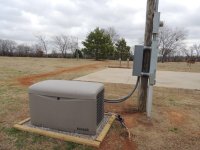That's why I am asking, it was a serious question. My assumption was that the problems came from people just back-feeding without turning off the breaker, and a transfer switch would make that impossible, but essentially perform the same task. If there is more to it I am curious. I don't have a generator so I have never done it, but couldn't see the risk. I am willing to learn.
BAP explained it well. The other risk is the one I mentioned, i.e., the generator feeding your entire house through a single 220v outlet.
Phase 1 - Extension Cord Mode - Like several others have shared, I started out with a portable generator and extension cords. The generator was pull start and it was loud. I had to be home to start it and layout the cords, usually bringing in a single cord in a partially open window from the generator, which was really fun in the winter. While the generator had a 220v outlet, I never took the step of connecting it to our 220v well pump.
This solution worked for a while and was better than nothing.
Phase 2 - Transfer Switch Mode - Happens when you get tired of running extension cords all over the place and install a transfer switch. Some opt for an automatic switch, others manual. You still have to be home to start the generator and flip the switch.
Phase 3 - Automatic Transfer Switch and Auto Generator Start Mode - When you get tired of having to be home to initiate, you get an automatic transfer switch installed that automatically starts your generator. No extension cords, no need to be home to start the process. There are variations of Phase 3. Some have generators they have to keep supplied with gasoline or diesel, some still use portable generators, some opt for permanent installations, others feed with NG or LP.
It all depends on how frequent outages are in your area, how long they last, and your lifestyle. Are you home to start the generator? Are you home to fill the tank? etc.
I am in Phase 3 using an automatic transfer switch that auto starts a Honda generator that powers all the circuits we need, including the well pump. The auto switch only supports one 220v circuit, so we can't power the hot water heater, so we only have hot water for a day or two, but for our area, that is usually not a problem. If it would become an issue, I could switch to an LP hot water heater.

